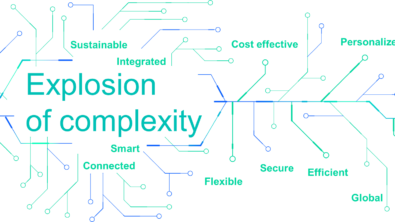MBSE for complex electronics design

For the fourth episode of Model Based Matters, where Tim Kinman and I talk with industry experts about the state of model-based systems engineering (MBSE) and the future of the methodology, we sat down with two voices from the world of electronics. Matt Bromley and Mark Malinoski were two amazing people to sit down with and get a lesson on what electronics development looks like in large systems of systems. From our conversation, the biggest hurdle in integrating electronics into the wider system is common understanding between the development domains. MBSE is a great tool for building that communication, but it requires a change in mindset from all stakeholders. To understand how to start that evolution, lets take a look at some of the highlights from episode four.
For many, the work in electronics development begins with a feature request from another area of development. Many other disciplines see these requests as black boxes, but just like we talked about in episode two, these requests create a contract between the different stakeholders. An electronic control unit may rely on specific data formats from other systems and must deliver precise information back after processing. But this contract is only the start of what can be considered a miniature MBSE framework for electronics development. Engineering is typically split into large domain groups – mechanical, electrical, electronic and software – but each of these consists of many subdomains. Mechanical engineering contains everything from structural performance to aerodynamics and electronics engineering is no different, aside from the much wider scales of development.
Wading into electronics from a feature request essentially produces a system architecture for the individual domain – requirements and sub-features are handed off to the different electronics domains like PCB design, integrated circuit (IC) design, and even to board component selection. Starting this entire process from scratch is a lengthy proposition and many teams want to short-circuit the process, pun slightly intended, this is where the MBSE process comes to the table. Defining these architectures early is important to not only initiate faster development, but this operation is still happening in the context of a larger system and customers want this information as early as possible to validate their own designs. MBSE enables more accurate preliminary designs and the possibility of re-using older components can easily accelerate the entire process.
For more information on what with process looks like for electronics development I’d highly recommend listening to the episode. My own experience in this world is limited and I would not do it justice to paraphrase these two experts. But there is another major point we discussed before we had to conclude our first meeting – complexity only grows as you zoom into individual domains in electronics development. As I understood it, it is like looking at a photo collage that creates a larger visual. From far away the whole make sense, the smaller areas are abstracted away, but as you get closer to the art the individual photos come into detail revealing a larger story while blurring the macro image you started with. In engineering, this is often short-handed as getting into the weeds, and for electronics this complexity can get out of hand very rapidly. That is why digital tools have been used for so long and why they will remain critical to development.
Model-based systems engineering will continue to grow in importance as electronics become more integrated into products. It handles the complexity of the boundaries between the domains and controls the information flows within them. The tolerances of electronics design are far different from those of mechanical systems and it is important to have a workflow to handle these difference. Unfortunately our conversation with Matt and Mark so fruitful that we ran out of time to get through the conversation in one episode. For the conclusion, where we talk about automating some of these highly complex tasks make sure to tune into episode five which is already out on your favorite podcast platform, or wherever you listened to this episode.
Siemens Digital Industries Software is driving transformation to enable a digital enterprise where engineering, manufacturing and electronics design meet tomorrow. Xcelerator, the comprehensive and integrated portfolio of software and services from Siemens Digital Industries Software, helps companies of all sizes create and leverage a comprehensive digital twin that provides organizations with new insights, opportunities and levels of automation to drive innovation.
For more information on Siemens Digital Industries Software products and services, visit siemens.com/software or follow us on LinkedIn, Twitter, Facebook and Instagram.
Siemens Digital Industries Software – Where today meets tomorrow


